Rachel Held Evans's Blog, page 7
April 30, 2015
Next Stop: Little Rock

© 2010 Sean Davis, Flickr | CC-BY-ND | via Wylio
I’ll be spending the next few days in Little Rock, Arkansas, where I’m excited to join Westover Hills Presbyterian Church for worship on Sunday morning and for their Cotham Lecture series Sunday night and Monday morning. All of these events are free and open to the public, and I’ll have copies of Searching for Sunday to sign and sell. Also, there will be food. Here’s the schedule:
Sunday, May 3:
Sunday worship, 10:25 a.m. (potluck luncheon after church in the fellowship hall)
Evening lecture and Q&A, 7 p.m. (reception to follow)
Monday, May 4:
Evening lecture and Q&A at 7 p.m.
On Sunday morning I’ll be speaking from John 15. The lecture series will focus on material from Searching For Sunday. Westover Hills Presbyterian Church is located at 6400 Richard B. Hardie Drive in Little Rock. Learn more here.



April 29, 2015
Searching for Sunday Excerpt: “Body”
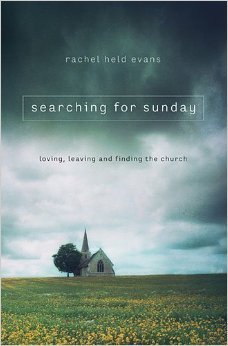
Today's post is an excerpt from my new book, Searching for Sunday: Loving, Leaving, and Finding The Church and is taken from a chapter entitled, "Body."
***
"You are the body of Christ, and each one of you is a part of it."
—1 Corinthians 12:27
“The church is a whore, but she is my mother.” The quote is attributed to St. Augustine, but no one’s really tracked it down. I’d venture to guess it originated with a man, though, and an unimaginative one at that.
It’s not that I don’t appreciate the sentiment—that despite her persistent wanderings and betrayals, the church births us and feeds us and names us children of God—it’ s just that when we leave men to draw all the theological conclusions about a metaphorically feminine church, we end up with rather predictable categories, don’t we?
Virgin. Whore. Mother.
But what might a woman say about church as she? What might a woman say about the church as body and bride?
Perhaps she would speak of the way a regular body moves through the world—always changing, never perfect—capable of nurturing life, not simply through the womb, but through hands, feet, eyes, voice, and brain. Every part is sacred. Every part has a function.
Perhaps she would speak of impossible expectations and all the time she’s wasted trying to contort herself into the shape of those amorphous silhouettes that flit from magazines and billboards into her mind. Or of this screwed-up notion of purity as a status, as something awarded by men with tests and checklists and the power to give it and take it away.
Perhaps she would speak of the surprise of seeing herself—flaws and all—in the mirror on her wedding day. Or of the reality that with new life comes swollen breasts, dry heaves, dirty diapers, snotty noses, late-night arguments, and a whole army of new dangers and fears she never even considered before because life-giving isn’t nearly as glamorous as it sounds, but it’s a thousand times more beautiful.
Perhaps she would talk about being underestimated, about surprising people and surprising herself. Or about how there are moments when her own strength startles her, and moments when her weakness—her forgetfulness, her fear, her exhaustion—unnerve her.
Maybe she would tell of the time, in the mountains with bare feet on the ground, she stood tall and wise and felt every cell in her body smile in assent as she inhaled and exhaled and in one loud second realized, I’m alive! I’m enfleshed! only to forget it the next.
Or maybe she would explain how none of the categories created for her sum her up or capture her essence.
If the church is like a body, like a bride, then perhaps we ought to take her through what Barbara Brown Taylor’s calls the “spiritual practice of wearing skin”:
Whether you are sick or well, lovely or irregular, there comes a time when it is vitally important to your spiritual health to drop your clothes, look in the mirror, and say, ‘Here I am. This is the body-like-no-other that my life has shaped. I live here. This is my soul’s address. After you have taken a good look around, you may decide that there is a lot to be thankful for, all things considered. Bodies take real beatings. That they heal from most things is an underrated miracle. That they give birth is beyond reckoning.
“When I do this,” she says, “I generally decide that it is time to do a better job of wearing my skin with gratitude instead of loathing.”
So let’s turn the mirror:
This is the church. Here she is. Lovely, irregular, sometimes sick and sometimes well. This is the body-like-no-other that God has shaped and placed in the world. Jesus lives here; this is his soul’s address. There is a lot to be thankful for, all things considered. She has taken a beating, the church. Every day she meets the gates of hell and she prevails. Every day she serves, stumbles, injures, and repairs. That she has healed is an underrated miracle. That she gives birth is beyond reckoning. Maybe it’s time to make peace with her. Maybe its time to embrace her, flawed as she is.
Maybe it’s time to smile back.
Sometimes I think the biggest challenge in talking about the church is telling ourselves the truth about it—acknowledging the scars, staring down the ugly bits, marveling at its resiliency, and believing that this flawed and magnificent body is enough, for now, to carry us through the world and into the arms of Christ.
Perhaps there is more to the church than mother and whore. And perhaps we might learn this from a woman.
***
Read more from Searching for Sunday.



April 23, 2015
"Like a Bird": Artist Ruth Meharg brings the 7 sacraments of "Searching for Sunday" to life
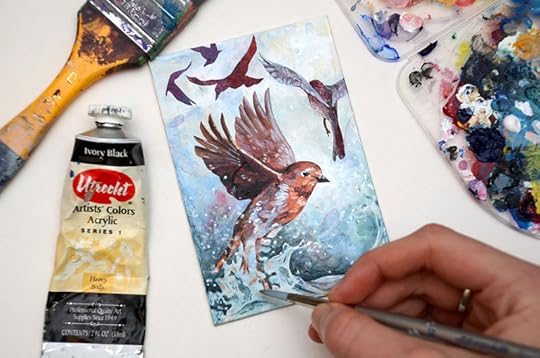
“…The Spirit is like a bird, fragile alloy of heaven and earth, where wind and feather and flight meets breath and blood and bones. The rabbis imagined her as a pigeon, the Celts a wild goose. Like a dove, she glided over the primordial waters, hovered above Mary’s womb, and descended onto Jesus’ dripping wet head. She protected Israel like an eagle, and like a hen, brooded over her chicks. ‘Hide me in the shadow of your wings,’ the poet king wrote. ‘Because you are my help, I sing in the shadow of your wings.’ The Spirit is as common as a cooing pigeon and transcendent as a high-flying eagle. So look up and sing back, catch the light of God in a diaphanous scrim of wing. Pay attention.” - from Searching for Sunday, Chapter 23, “Breath”
***
One of the greatest joys of writing creatively is seeing how other artists interpret, engage, and play with the themes of your work. Searching for Sunday has provided ample opportunity for creative collaboration because the sacraments at the heart of the book—baptism, confession, holy orders, communion, confirmation, anointing the sick, and marriage—are rich and complex and endlessly inspiring.
For my sister, Amanda, the sacraments inspired an album of seven songs. And for artist Ruth Meharg, they inspired a series of small acrylic paintings that employ the symbolically-rich imagery of birds.
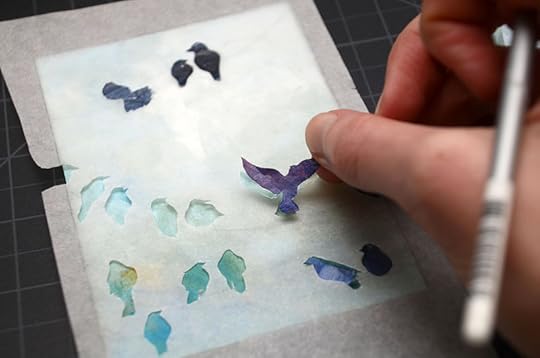
Ruth is an artist, illustrator and lover of all things beautiful. Raised in a big, loud and loving family in Fort Worth, Texas, she says her parents gifted her a love of art and travel at an early age. In 2013 she received her BFA in illustration from Savannah College of Art and Design and married her artist husband, Matthew. You can find her amazing work at www.RuthMeharg.com, where you can also order prints of this series on the seven sacraments.
I wanted to invite Ruth to share a little about the thought that went into these paintings, and am so glad she agreed to let us into her world. Enjoy!
***
From Ruth: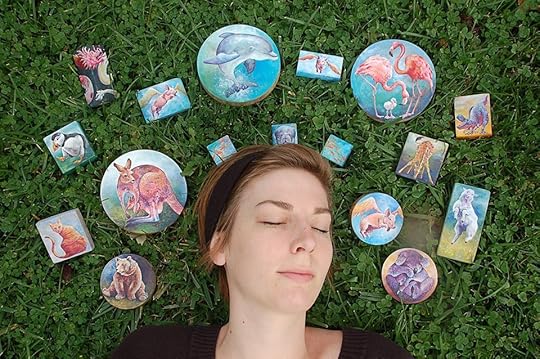
I didn't grow up with the sacraments. In fact I'm pretty sure I didn't have any idea what they were until after graduating high school. As my world expanded, they began to sneak in every so often. Sometimes during a visit to a Catholic church or perhaps in a friend's post about liturgy.
Despite my growing awareness, I approached Searching for Sunday with a limited awareness of the sacraments and what they meant to the church. I came away with a deeper understanding of the sacraments in general, and of what those sacraments mean to me.
These images are my thoughts, my revelations and my questionings during my month of exploring the sacraments. They are my journey with the sacraments, and in many ways with the church as a whole. And, following in Jesus' parable telling footsteps, I'm telling my story through a bit of symbolism. Birds.
Why birds? Well, throughout art history, and especially in Christian art, birds have been used to represent people. They stand in for every color, gender, age, body type, political leaning and religious affiliation. They represent humanity in all its richness. I tried to represent this by illustrating birds of all shapes and sizes from around the world. My hope is that, whoever you may be, you see yourself and your relationship to the sacraments in these feathered creatures.
Baptism: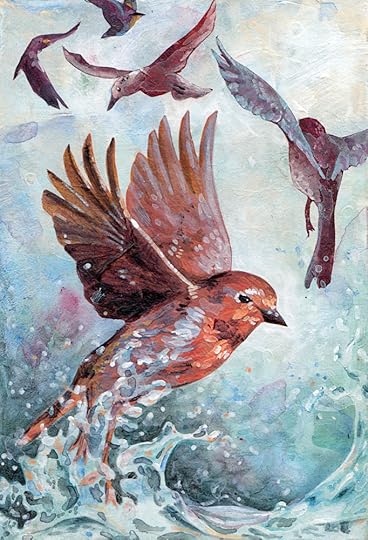
Out of all the sacraments, baptism evokes the clearest and most powerful imagery in my mind. I see ascending doves and flowing rivers, death and life and water everywhere. Baptism isn’t passive, it isn’t quiet, it isn’t slow and it’s never done alone. This painting is what baptism feels like, and I think the image describes it much better than my words ever will.

The nightingale sings even in the darkness of the night. In the Hans Christian Andersen fairy tale, the nightingale’s song drives away death and brings new life with the rising sun. This is how I see confession. An act that brings light and life, even in darkness. And although there are only two birds in this painting, I imagine that if we could zoom out a bit, the whole branch would be full of birds. A congregation, confessing with the rising sun.
Holy Orders:
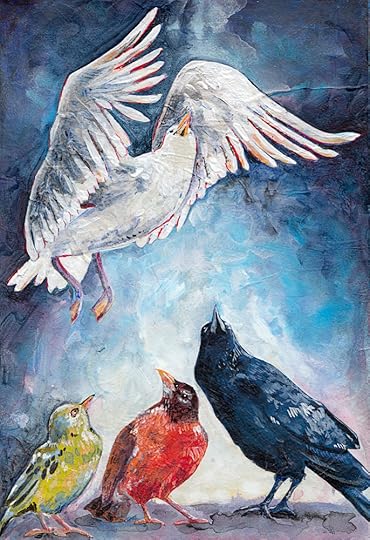
Holy Orders is the commissioning, the sending out of one of our own. These birds, in all their diversity of color, size and song, come together to commission one of their own. To send out one of their fellows with joy and support in the great adventure of spreading one’s wings and heading into the world.
Communion:
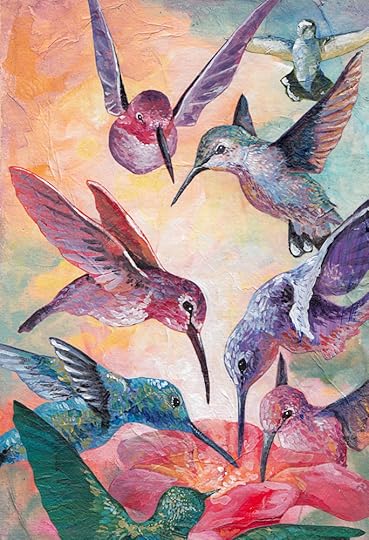
Communion was not my favorite thing as a child. I've never had an appreciation for grape juice and stale crackers, so for this image I didn't want to paint birds picking over seeds, bread crumbs or bugs. I wanted to paint a rich, enticing image of communion - a communion I would want to partake in.
Confirmation:
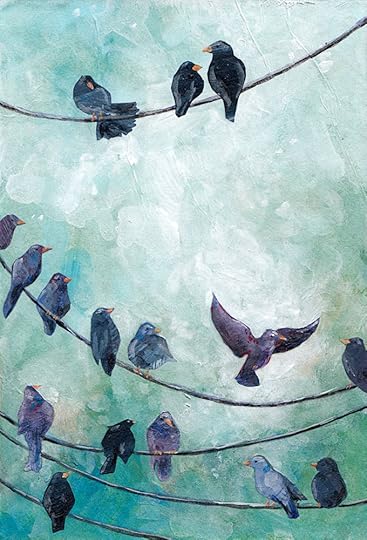
Confirmation is a welcoming. As soon as I understood that, I pictured rows of little birds sitting on their telephone lines, scooting over to make room for the newcomer. Because there is always room. We can scoot over forever and those lines will never be so full that we can’t make room to welcome one more.
Anointing of the Sick:

If any bird sums up anointing of the sick, I think it must be emperor penguins. Those strange birds that waddle for hundreds of miles together, feed each other, raise their children together and protect each other through the fiercest storms. So I painted these penguins in their huddle that brings shelter from the storm. The huddle of gentle love and slow healing.
Marriage: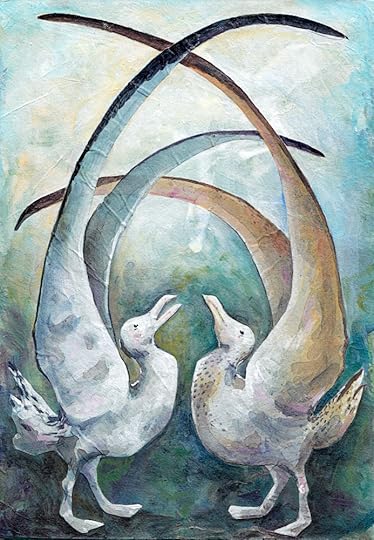
Albatrosses are the most faithful of all birds. They choose their partner carefully, and they return to that partner over and over again for the rest of their lives. I love that image. To me marriage is a choice to return, over and over again, every day. I think that is what the sacraments are too. A choice to return, over and over. A choice to remember when we share a meal, a choice to stand by a hurting friend, a choice to welcome strangers with open arms. A choice to practice faithfulness over and over again, every day.
***
Be sure to check out Ruth’s Web site at www.RuthMeharg.com, where you can see more of her beautiful work and order prints of this series. Ruth was kind enough to send me the originals—one of the sweetest, most humbling gifts I’ve received as a writer, and which, in the spirit of eucharisteo, I received with thanksgiving.
You can listen to Amanda Opelt's album, Seven Songs, here. Find out where to get your copy of Searching for Sunday here.
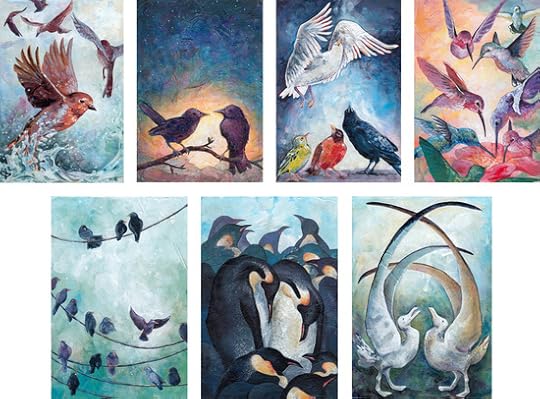



April 22, 2015
Searching for Sunday Audiobook & Discussion Guide

Many of you have asked about the Searching for Sunday audiobook, which I’m happy to announce is now available at Audible.com and all major online audio retailers. I had a blast recording the narration for this book at Paragon Studios in Nashville (in the very booth, I am told, where Larry the Cucumber records his lines for Veggie Tales productions), and would be honored to accompany you on your next road trip or morning run.
We also decided to give everyone to access to the Searching for Sunday discussion guide, (which was originally one of the items available only to people who bought five or more copies). You can find the downloadable discussion guide, now available to everyone for free, on the Searching for Sunday book page. We hope this is useful to book clubs and discussion groups.
Thank you for reading/listening!



April 14, 2015
Release Day Surprise: Free Album with “Searching for Sunday”
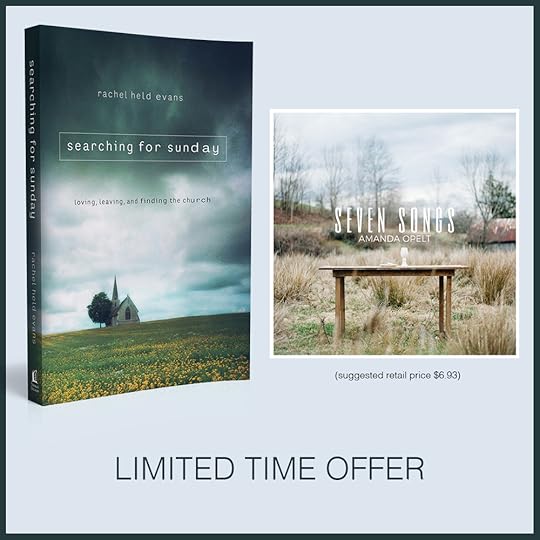
Today I’m thrilled to celebrate with you the release of my new book, Searching for Sunday: Loving, Leaving, and Finding the Church. Arranged around the imagery of seven sacraments, it’s a book about all that is frustrating and beautiful and complicated about church, and I dedicated it to you, the readers of this blog, and also to my sister, Amanda Opelt, who has a special surprise for us today.
Amanda is a singer/songwriter out of Boone, North Carolina, and she’s celebrating a big day today too: the release of a new album entitled Seven Songs, which was inspired by the seven sacraments featured in Searching for Sunday.
Take a listen to the first track "Snow (Baptism)":

photo by Erin Deuel
These songs are haunting, beautiful, and lyrically profound. Amanda and I have always been close in mind and spirit, but there were moments in listening to the first cuts of “Seven Songs” that I felt she had reached into my brain and put my best dreams into song. (The “Marriage” song will totally wreck you.) Written and recorded in the mountains of western North Carolina, the album is the effort of a community of musicians and artists seeking to creatively express the longing inherent in each of the sacraments: the hunger for new life, healing, and harvest. It’s the perfect companion work to Searching for Sunday.
“Seven Songs” releases today on all major platforms including iTunes and Amazon with a suggested retail price of $6.93.
...But you can get it for free!
Anyone who purchases a copy of Searching for Sunday and submits their proof of purchase by April 18th at 11:59PM EDT will get a download code to get the entire album for free! If you've already submitted your proof or purchase, there's nothing else you need to do.
If you haven't bought Searching for Sunday yet, now would be a great time.
The promotion ends Saturday April 18th, 2015.IMPORTANT: Once you’ve submitted your proof of purchase, you can expect an email delivered to your inbox by Tuesday April 21st, 2015 with your download code which will be redeemable directly at the album distributor's Web site: http://catapult.codes
For Promotion Details visit the Launch Celebration page.


April 7, 2015
One Week Left (and a surprise)
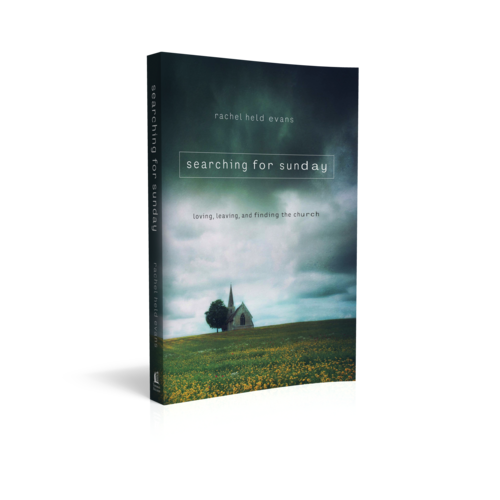
Next Tuesday, April 14th, is the official release date of Searching for Sunday, my latest book. It explores all that is beautiful and ugly and complicated about the church, through the imagery of seven sacraments.
If you order the book now and submit your proof of purchase you get access to the first three chapters immediately, plus the other gifts that are part of the Launch Celebration.
Today I’m happy to announce that we’re adding a top-secret surprise gift to the mix that is unlike any of the others and something I am very excited about.
There are a few more behind-the-scenes things that need to happen before we can announce the additional gift, but we're planning on revealing the details next week. If you've already taken advantage of the promotion and submitted your proof of purchase, there's nothing else you need to do. You'll automatically get more details delivered to your email inbox after launch week.
If you haven't snagged your copy of Searching for Sunday yet, this would be a good time! This promotion is temporary. After April 18th, it's gone.
It’s been such a joy to hear stories of how the book has impacted those who have read early copies, and I love how the imagery of the seven sacraments has already inspired creative and artistic responses.
Learn more about the Launch Celebration promotion.



April 6, 2015
The Women of Holy Week, Part 5: Mary Sees The Risen Lord
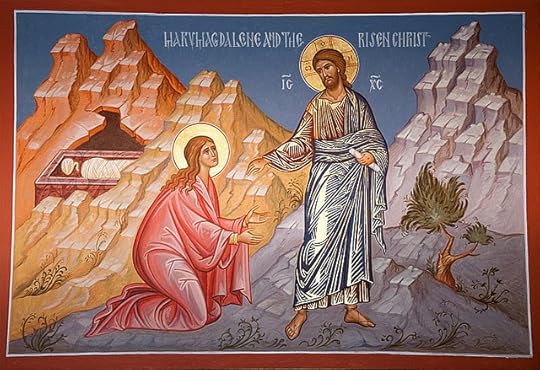
© 2011 Ted, Flickr | CC-BY-SA | via Wylio
"Mary Magdalene went to the disciples with the news:
'I have seen the Lord!'"
—John 20:18
The story of how Mary Magdalene became known as a prostitute is a complicated one.
One of at least six Marys that followed Jesus as a disciple, she was distinguished from the others through identification with her hometown of Magdala, a fishing village off the coast of the Sea of Galilee. According to the gospels of Mark and Luke, Jesus cleansed Mary of seven demons, after which Mary became a devoted disciple, often mentioned by Luke in the same context as the Twelve.
In 597 Pope Gregory the Great delivered a homily on Luke’s gospel in which he combined Mary Magdalene with Mary of Bethany (Martha’s sister), suggesting that this Mary was the same woman who wept at Jesus’ feet in Luke 7, and that one of the seven demons Jesus excised from her was sexual immorality. The idea caught on and was perpetuated in medieval art and literature, which often portrayed Mary as a weeping, penitent prostitute. In fact, the English word maudlin, meaning “weak and sentimental,” finds its derivation in this distorted image of Mary Magdalene. In 1969, the Vatican formally restated the Gospels’ distinction between Mary Magdalene, Mary of Bethany, and the sinful woman of Luke 7, although it seems Martin Scorsese, Andrew Lloyd Webber, and Mel Gibson have yet to get the memo.
A cynic might suggest that this mistake and its subsequent popularity represent a deliberate attempt to typecast and discredit a woman whose role in the gospel story is so critical and so revolutionary that the Eastern Orthodox Church refers to Mary Magdalene as Equal to the Apostles.
Although she appears to have been a critical part of Jesus’ early ministry, Mary Magdalene’s extraordinary faithfulness shines most brightly in the story of the Resurrection.
Gospel accounts vary, but all four identify Mary Magdalene as among the first witnesses of the empty tomb.
According to the Synoptic Gospels, she and a group of women rose early that fateful morning, three days after Jesus had died, to anoint the body with spices and perfumes. When they arrived at the tomb, they were met by divine messengers guarding the entrance, who declared that Jesus had risen from the dead, just as he said he would. The women immediately left the tomb behind and, “with fear and great joy,” (Matthew 28:8) ran to tell the other disciples.
Luke notes that on their way, they remembered what Jesus had taught them about resurrection, confirmation of the fact that these women had been present for some of Christ’s most important and intimate revelations and that they took these teachings to heart.
But when the breathless women arrived at the home where the disciples had gathered, the men did not believe them. Women were considered unreliable witnesses at the time (a fact that may explain why the apostle Paul omitted the women from the resurrection account entirely in his letter to the Corinthian church), so their proclamation of the good news was dismissed by the men as an “idle tale,” the type of silly gossip typical of uneducated women. Perhaps the men invoked the widely held belief that, just like their sister Eve, women were easily duped.
A few, however, were curious enough to take a look at the tomb, and so, according to John’s account, Mary returned with Peter and another disciple to the place she had encountered the messengers. The men saw for themselves an empty grave and a pile of linen wrappings folded neatly within it, and conceded to the women that the tomb was indeed empty. However, John 20:9 notes, “they still did not understand from Scripture that Jesus had to rise from the dead.”
The men returned to report what they had seen to the rest of the disciples, leaving Mary behind.
Perhaps the disciples posited the theory that Jesus’ body had been stolen, for John wrote that Mary, once so full of breathless excitement and impassioned belief, now stood outside the tomb, crying.
Angels appeared and asked her what was wrong.
“They have taken my Lord away,” she told them, “and I don’t know where they have put him”
The angels were then joined by a mysterious man. Mary assumed he was the gardener. He, too, asked why she was crying.
"Sir, if you have carried him away, tell me where you have put him, and I will get him,” she pleaded.
Only when he called her by her name did she recognize the man as Jesus.
“Mary,” he said.
“Rabboni!” she cried.
She knew him as her teacher, her rabbi.
“Do not hold on to me,” Jesus urged as she fell before his feet, “for I have not yet ascended to the Father. Go instead to my brothers and tell them, ‘I am ascending to my Father and your Father, to my God and your God.”
And so again, Mary Magdalene ran to the house where the disciples were staying and told them she had seen the risen savior face-to-face.
“I have seen the Lord!” she declared.
Stephen J. Binz, in his wonderful book The Women of the Gospels, notes that "her announcement, 'I have seen the Lord,' is the same credential used by Paul to insist on his own authority as an apostle: 'Am I not an apostle? Have I not seen Jesus our Lord?' (1 Cor. 9:1). The church's belief in the resurrection originated with the evangelical witness of this woman."
Far from being easily deceived, women were the first to make the connection between Christ’s teachings from Scripture and his resurrection, and the first to believe these teachings when they mattered the most. For her valor in twice sharing the good news to the skeptical male disciples, the early church honored Mary Magdalene with the title of Apostle to the Apostles.
That Christ ushered in this new era of life and liberation in the presence of women, and that he sent them out as the first witnesses of the complete gospel story, is perhaps the boldest, most overt affirmation of their equality in his kingdom that Jesus ever delivered.
And yet too many Resurrection Sunday services allow only men to stand before the congregation and shout, “He is risen!” to a chorused response of “He is risen indeed!”
Were we to honor the symbolic details of the text, that honor would belong to a woman.
***
The Women of Holy Week, Part 1: Why the Women Matter
The Women of Holy Week, Part 2: The Woman at Bethany Anoints Jesus
The Women of Holy Week, Part 3: Mary's Heart is Pierced (Again)
The Women of Holy Week, Part 4: The Women Wait


April 4, 2015
The Women of Holy Week, Part 4: The Women Wait
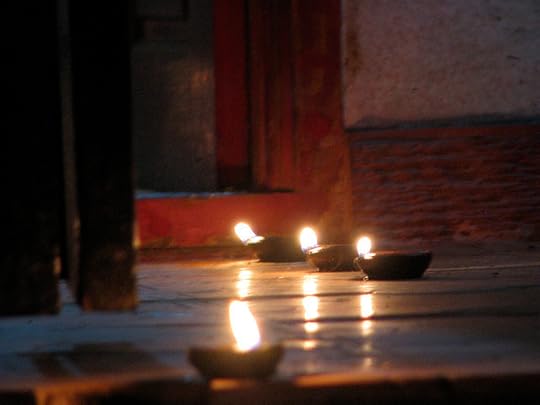
© 2008 McKay Savage, Flickr | CC-BY | via Wylio
“The women who had come with him from Galilee followed,
and they saw the tomb on how his body was laid.
Then they returned, and prepared spices and ointments.
On the Sabbath they rested according to the commandment.”
– Luke 23:55-56
The final hours of the first Good Friday had been frantic ones.
Most of Jesus’ disciples had abandoned him, leaving the few remaining, mostly women, with a body to bury. According to Jewish law, no work could be done once the sun set, so they had to hurry.
Thankfully, Joseph of Arimathea, a secret disciple of Jesus, donated a tomb for the burial, and Nicodemus, a Pharisee, donated myrrh and aloes to cover the stench. Jesus’ body was placed in the tomb, but the important job of preserving it with spices would have to wait until the Sabbath was over.
Anyone who has observed a traditional Jewish Sabbath knows the strange tempo of hurriedness followed by stillness that fills the hours just before and after sunset. All meals must be prepared ahead of time, all tasks completed before the day of rest begins. Whatever one has left undone at sunset must remain undone for a full 24-hours. One cannot cook or lift or mend or conduct business, and so without adequate preparation, one can feel displaced, incomplete, even helpless.
What a terrible Sabbath this must have been for the women who followed Jesus! It was their traditional role as women to anoint a body with perfumes and spices, but they hadn’t had time. They had been busy finding a decent place to bury their friend and teacher so that his body would not have been left to the elements by disinterested Roman guards. They must have felt such a heavy, powerful sense of incompleteness, such a profound lack of closure. Their work was not yet done, but still, they had to wait.
Did they pray together?
Did they sit in stunned silence, eyes tired and heavy from weeping?
Did they rehash Friday’s events in agonizing detail?
Did they whisper about that story the rabbi once told of a temple being rebuilt in three days?
We have little information about what the women did on this, the darkest day in Christian history. Only Mark gives us a glimpse of what was being discussed in the hours leading up to Resurrection Day:
“[The women] had been saying to one another, ‘Who will roll away the stone for us from the entrance of the tomb?”
They were worried about the logistics.
They had no idea how, without the help of men, they could move away that heavy stone.
But as soon as the blue light of dawn seeped through the windows in the morning, the women rose and, in an act of radical friendship and faith, went to the tomb anyway...
***
The Women of Holy Week, Part 1: Why the Women Matter
The Women of Holy Week, Part 2: The Woman at Bethany Anoints Jesus
The Women of Holy Week, Part 3: Mary's Heart is Pierced (Again)


April 3, 2015
Women of Holy Week, Part 3: Mary's Heart is Pierced (Again)
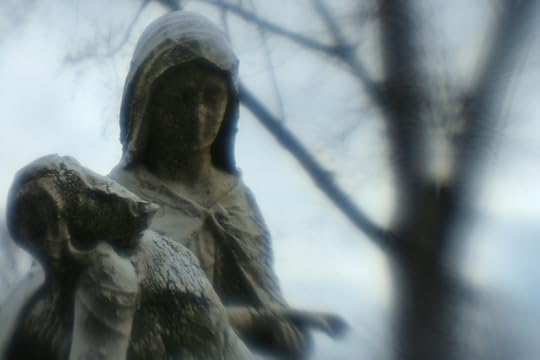
© 2011 John Morgan, Flickr | CC-BY | via Wylio
Then Simeon blessed them and said to Mary, his mother:
‘This child is destined to cause the falling and rising of many in Israel,
and to be a sign that will be spoken against,
so that the thoughts of many hearts will be revealed.
And a sword will pierce your own heart too.’’
– Luke 2:33-34
Tradition holds that Mary suffered seven sorrows: her flight to Egypt to escape the infanticide, Simeon’s prophecy that her heart would be pierced, those panicked days in Jerusalem when she thought she had lost Jesus in the crowd, walking with Jesus to Calvary, watching her son’s execution, holding his body in her arms, and placing him into the cold tomb.
But there would have been many more sorrows for Mary along the way: when her son left home to travel and teach, when he nearly killed himself fasting for forty days in the wilderness, when whatever happened to Joseph happened to Joseph, when Jesus responded to the announcement of his mother’s presence by saying to his disciples “Who are my mother and my brothers? Whoever does God’s will is my brother and sister and mother.” He was making a point, she must have known, but still, it had to pierce her heart a little.
And as every mother knows, Mary also experienced the quotidian sorrows of motherhood: the first bruised knee, the unkind words of other children, the frightening illnesses, the surprised eyes of a little boy the first time he witnesses injustice, cruelty, or the suffering of another, the gifts she wished she could give him, the memories she wished she could preserve forever, the disappointments she wished with all her heart she could stop.
Sometimes I imagine Mary breathlessly recounting Simeon’s strange prophecy to her friends while they nursed together under the shade of a tree, only to hear the mothers in the group laugh and say, “What kind of prophecy is that? You are a mother! Of course your heart will be pierced. It will be pierced every day.”
Fittingly, Mary watched her son’s crucifixion in the company of other mothers. The Gospel writers describe them as being both “at a distance” and close by. At one point, Jesus looks at his mother and says, “Woman, here is your son.”
The cross is a complicated, frightening thing. There, the God of the Universe experienced every imaginable suffering of his creation, right down to the sense of isolation and betrayal when the Divine seems far away. Because of the cross, we are connected to God through suffering. Because of the cross, we can never say God doesn’t understand.
In this moment, when Mary’s eyes locked with the eyes of the boy she once nursed, once tickled, once watched fall asleep, I imagine Jesus understood the suffering of mothers, perhaps the most powerful suffering of all.
Mary was not the first, nor the last, mother to hold the broken body of her child in her arms. She was not the first, nor the last, to weep in the company of mothers as they stumbled their way to an open grave. It happens every day—when famine claims another little life, when the sudden arrival of blood represents the end of a pregnancy, when cancer strikes yet again, when the phone rings and the news is bad.
It is a pain that pierces the heart.
And, because of today, because of the cross, it is a pain even Mother God understands.
***


April 2, 2015
The Women of Holy Week, Part 2: The Woman at Bethany Anoints Jesus
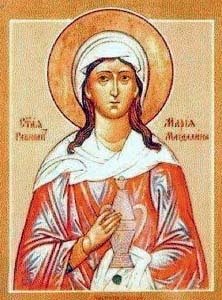
They say that of the five senses, smell is most closely linked to memory. The phenomenon has something to do with the olfactory bulb in the brain’s limbic system and how it forever links the scent of soap and freshly-cut lavender to the security of your grandmother’s guest room.
Scent, unlike anything else, brings us back.
So it is strange that in the most aromatic of the Passion stories, our collective memory fails us.
We know there is a woman.
We know there is an anointing.
We know there is expensive, perfumed oil.
We know there is a protest.
But when it comes to the details of the woman’s anointing of Jesus, accounts vary.
Matthew and Mark describe an unnamed woman from Bethany who, while Jesus dined in the home of Simon the Leper just days before his death, anoints his head with expensive ointment to the chagrin of the disciples at the table, who grumble that her offering might be better spent on the poor.
John identifies the woman as Mary of Bethany, the sister of Martha and Lazarus, who bathes Jesus’ feet in perfume and wipes them with her hair. In John’s account, it is Judas who chastises Mary for her waste.
Luke writes of a “woman of the city, who was a sinner,” who bathes Jesus’ feet in a mixture of perfume and tears, wiping his feet with her hair and kissing them with her lips. In this story, a Pharisee condemns her, noting that “if this man were a prophet, he would have known who and what sort of woman this is who is touching him, for she is a sinner.”
Whether these accounts represent one event or two, or possibly even three, has been the subject of speculation for centuries. It’s easy to get frustrated with the writers of Scripture, who are so careful to name and distinguish the Twelve, but who often blur the Women together. The Scholars Version note to Mark 14:3-9 states: "… It must be unintentional irony when Mark has Jesus predict that this story will always be told in memory of a woman whose very name escapes him."
But the account most commonly tied to the Passion is that of Matthew, Mark, and John:
Just days before his betrayal and death, Jesus and his disciples were eating at the home of Simon the Leper in Bethany. While they were reclining at the table, a woman, who John identifies as Mary of Bethany, approached Jesus with an alabaster jar of expensive perfume, worth about a year’s wages. Mary broke the jar of spikenard, pouring the perfume on Jesus’ body. The house filled with its pungent, woody fragrance as she anointed Jesus’ head and feet.
Everything about the incident is offensive—an interrupted meal, an excessive gift, a woman daring to touch a man with her hair.
It's also highly symbolic.
In Jesus’ culture, the act of anointing signified selection for some special role or task. Kings were often anointed with oil as part of their coronation ceremony, usually by a prophet or priest. The Greek word christos, Christ,” is a translation of the Hebrew word for Messiah, which means “the anointed one.” And so this anonymous woman finds herself in the untraditional position of priest and prophet. In the upside-down Kingdom of Jesus, it makes perfect sense.
Anointing the feet took things a step further, modeling the service, discipleship, and love Jesus taught. In a culture in which a woman’s touch was often forbidden, Mary dares to cradle the feet of Jesus in her hands and spread the oil across his ankles and toes with the ends of her hair. And rather than measuring out a small amount of oil, Mary breaks the jar lets it all pour out. She’s all-in, fully committed, sparing no expense. The oil she may have been reserving for her own burial, or the burial of a loved one, has been poured out generously, without thought of the future.
The humility of this action foreshadows the footwahsing that is to come and that we remember on this Maundy Thursday. Later, Jesus would imitate Mary by washing the feet of the Twelve, telling them to do the same.
But in the midst of all this symbolism and foreshadowing, Jesus sees something else at work. He interprets the woman’s act of worship as preparation for his burial. When the disciples rebuke the woman for what they see as a waste of money, Jesus responds by saying, “Let her alone; why do you trouble her? She has performed a good service for me. For you always have the poor with you, and you can show kindness to them whenever you wish; but you will not always have me. She has done what she could; she has anointed my body beforehand for its burial.”
Jesus had been speaking of his impending death for a while, but the Twelve were having none of it. When Jesus told Peter that “the Messiah must be rejected, suffer, and die; then he will be raised,” Peter responded with such an impassioned protest that Jesus rebuked him with “get behind me Satan!” In another instance, Jesus spoke ominously of his death, and the disciples respond by debating who will be the greatest in the coming kingdom. And in another, James and John miss the point entirely by responding to Jesus’ prediction with requests to sit at his right and left hand.
Clearly, the Twelve struggled to conceive of a kingdom that would begin not with the death of their enemies, but with the death of their friend. I suspect this is why they complained about the “waste” of money exhibited by the anointing. They imagined that their ministry with Jesus would continue for months and years to come. You can sense the sadness in Jesus’ words when he reminds them, yet again, that he will not always be with them, that he is preparing for the most difficult days of his life.
We cannot know for sure whether the woman who anointed Jesus saw her actions as a prelude to her teacher’s upcoming death and burial. I suspect she knew instinctively, the way women know these things, that a man who dines at a leper’s house, who allows a woman to touch him with her hair, who rebukes Pharisees and befriends prostitutes, would not survive for long in the world in which she lived.
Surely a woman in this society would understand this better than a man.
Perhaps this is why the women stayed by Jesus’ side after so many of the Twelve betrayed him, denied him, and fled from him in fear. This was the course of things, the women knew. They would see it through to the end.
And so the woman of Bethany becomes the first of Christ’s disciples to really acknowledge his impending death. For this, Jesus praises her in unparalleled terms. “Truly I tell you, wherever the good news is proclaimed in the whole world, what she has done will be told in remembrance of her.”
What a remarkable thought—that at every communion, every Easter service, every cathedral and every tent revival, from Israel to Africa, to Europe to China, this woman’s story should be on our lips, right along with Christ’s.
And yet, while we break the bread and drink the wine, we rarely pour out the oil. Rarely do we allow its scent fill the room and bring us back.
Jesus wanted us to remember, but we have forgotten. We aren’t even sure of this woman’s name.
Maybe we should bring back this oil, this costly perfume, and make it part of our Eucharist. Maybe, with the help of the Spirit, the scent will trigger our memory.
***
See also: The Women of Holy Week, Part 1: Why the Women Matter


Rachel Held Evans's Blog
- Rachel Held Evans's profile
- 1710 followers



